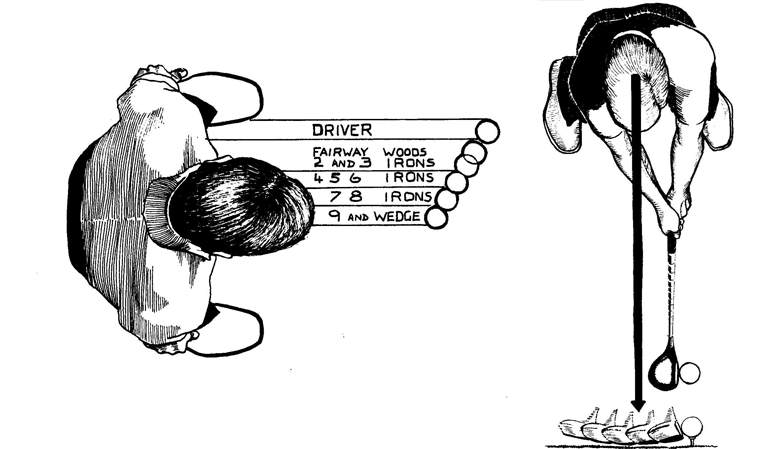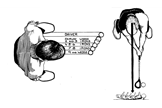Practice makes permanent
Last updated:
I first swung a golf club at the age of 14; from that very first time, I knew I’d found what I wanted to do for a living. As a junior member of Cradoc Golf Club, in the Brecon Beacons National Park, I started to practise every day. My first Slazenger practice bag held about 80 balls. If 80 practice shots a day was supposed to cause improvement, then surely 160 shots a day would bring faster and greater progress. Pretty soon I found myself hitting 500 every day, come rain, wind or shine. Unbelievably, I wore the grooves out of my short and mid-irons in an 18-month period!
With 20/20 hindsight, I now realise the old adage “practice makes perfect” is untrue – practice makes permanent! Only, appropriate practice makes perfect. Sadly, by the age of 16, I had an imperfect golf swing that was so ingrained it would need a magician to repair the damage! By the time I was 20, despite becoming a fully qualified PGA professional, my swing was profoundly flawed and my scoring was erratic to say the least.
Happily, between 1978 and 1983, I would make a pilgrimage from South Wales to Woburn, to take lessons from the late, great Alex Hay. A number of Welsh youngsters would share the journey with me, one of note being Phil Price of Pontypridd Golf Club. I made that trip four or five times a year, for five years; it allowed me to receive tuition from one of the greatest teachers of all time. In addition, watching my friends being taught by Alex gave me a radical insight regarding teaching golf. That insight led to Alex offering me the post of Head Professional at Woburn in 1984; they have been 30 fascinating, rewarding and exciting years a club professional could wish for. I enjoy teaching golf now, more than ever and am still learning my craft on a daily basis.
So, let’s see if I can help you practise effectively, avoiding those pitfalls I succumbed to in my mistaken pursuit for “perfection”.
Fault #1: Practice is to groove a swing
This fundamental supposition is based on the false premise that we swing every club the same. How can that be true when we have 13 long clubs in our bags, varying from 44-inch drivers to 36-inch wedges? The driver demands a long, full swing on a flattish plane, whereas the wedge will require a much more upright, shorter swing.
FIX: Warm up with your short irons; then progress through the bag to hit some drivers. Finish your session with a few 6-iron shots, so that you finish with the middle club of 13. This way you go home with a “neutral” swing feeling; one that is not extremely flat or upright.
Fault #2: Quantity before quality
So often at driving ranges, earnest golfers are “machine gunning” drivers away, getting through a couple of hundred balls a session. Golf is played with a variety of clubs, requiring differing skills; only smashing drivers is detrimental to your overall game.
FIX; Hit a maximum of 70 to 80 balls in a “long game” practice session. But – take your time over each one; ideally rehearsing the pre-shot routine that you use on the course. Far better to practise as you hope to play – 80 balls hit with concentration and purpose are far more effective than 200 hit like a gatling gun!
Fault #3: Aiming at nothing
Butch Harmon recounts he was out on the range slamming shots away in a carefree manner. His famous dad, Claude, walked by – “how am I swinging it pop?” enquired Butch. The curt reply returned – “you’re swinging it great if you are aiming at the mountains; you’re swinging it **** if you’re aiming at a flag!” Butch had learned hitting balls at “nothing” means nothing.
FIX Pick a specific target. lf shots are required to hit a target, be they fairways, greens or flagsticks. It is vital to choose specific targets when practising; how else are you going to present your shaft, clubface or body to the target line? Also, it is essential to know your carry distances with all your clubs. Use a rangefinder to ascertain how far or near your target is.
Fault #4: Inconsistent ball position
Following on from the previous fault of aiming badly, we must have good body and shaft alignment if we are going to understand correct “ball position”. Appreciate the swing is not a groove, but changes from club to club. Now it makes sense to have the ball positioned differently for each club.
FIX There are two schools of thought regarding “ball position”. Firstly, the “constant” ball position, where the ball is opposite the left armpit. Secondly, a “progressive” ball position, where the ball is centre of stance with a wedge, moves towards the left instep with a driver. Biomechanically and ballistically, the “progressive” ball position is the correct choice. Here is a lovely drawing by Alex Hay (left) to demonstrate what it looks like from above.

